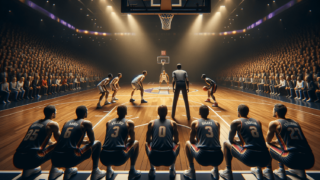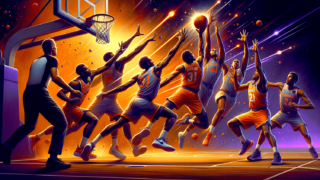
Inadvertent Whistle in Basketball: Rules and Procedures
Written by: Basketball Universe
Last updated:

In the fast-paced world of basketball, it’s easy to get swept up in the heat of the moment. One such incident that captures the spirit of the game in its raw and ever-changing nature is the famed ‘inadvertent whistle’. If you’ve ever found yourself scratching your head in bafflement at this unique aspect of the sport, then buckle up, because you’re about to receive a delightful crash course. In this blog post, we will explore the ins and outs of the inadvertent whistle, diving into the fascinating territory of rules and procedures that govern this occasional hiccup in basketball’s fabric. So, lace up your sneakers and let’s get started!
Inadvertent Whistle in Basketball: Rules and Procedures
An inadvertent whistle occurs when a basketball official mistakenly blows their whistle during gameplay, mistakenly signaling a stoppage in play. When this happens, the rules dictate that the clock should be stopped immediately, and depending on the situation, the ball may be returned to the team that last had possession, a jump ball may occur, or free throws might be awarded based on prior actions. Officials handle inadvertent whistles by reviewing the circumstances surrounding the mistake and applying the appropriate procedures to minimize the impact on the game.
Understanding the Inadvertent Whistle
Before we delve into the different scenarios that give rise to an inadvertent whistle in basketball, it’s crucial to first understand what it actually is. An inadvertent whistle refers to the situation where an official accidentally blows their whistle, interrupting the flow of the game without a legitimate reason for stoppage. These instances can confuse not only the players and coaching staff but also spectators, leaving everyone in a state of momentary bewilderment. As with all basketball rules, there are specific procedures in place to manage these unexpected disruptions and ensure the game progresses fairly.
Causes Leading to Inadvertent Whistles
Identifying the various causes leading to inadvertent whistles can help officials and players alike prevent their occurrence. So, let’s break down some of the most common causes:
1. Misinterpretation of plays
Occasionally, a referee might misinterpret a play or action, leading them to blow their whistle when it wasn’t necessary. For example, they may think they saw a violation, such as a double dribble or a travel, but upon further thought or consultation with fellow officials, realize that the call was incorrect.
2. Anticipation of violations
One of the primary reasons officials end up blowing an inadvertent whistle is due to anticipation. They might expect a certain action or violation to occur and react prematurely, only to realize that their assumption was not valid.
3. Whistle malfunction
Although rare, there have been cases where the whistle itself malfunctions or gets caught in the official’s lips, resulting in an unintentional whistle.
4. External influences
At times, external noises or events during the game can cause referees to mistakenly blow their whistle, such as a loud noise resembling a whistle from the crowd, triggering a subconscious response in the officials.
How to React to an Inadvertent Whistle
Now that we’ve covered some of the typical causes leading to inadvertent whistles, let’s take a look at the proper way to handle them from both the officials’ and the players’ perspectives:
For Officials:
When an inadvertent whistle occurs, the official that blew the whistle should immediately signal the error by tapping the chest and acknowledging their mistake. Officials should then confer with their colleagues to reach a consensus on how best to proceed based on the current state of the game and the rules applicable to the specific situation.
For Players:
When a player hears an inadvertent whistle, they should stop playing immediately and await further instructions from the officials. Coaches should also use this opportunity to instruct their players on how to react in future inadvertent whistle situations, as well as clarify the ruling from the officials.
Rules and Procedures for Handling Inadvertent Whistles
With the officials and players reacting appropriately to an inadvertent whistle, the next step is to determine how the game should resume. There are three primary methods for handling this situation according to basketball rules:
1. Returning the ball to the team that last had possession
If the inadvertent whistle occurred while the ball was in the air, out of bounds, or in the control of a player, the team that last had possession will regain control. The officials will then inbound the ball from the spot closest to where the whistle was blown, giving the offensive team a new shot clock of 14 seconds (in FIBA and NBA) or a reset of the shot clock to 15 seconds (in NCAA).
2. Resorting to a jump ball
In cases where it’s unclear which team last had possession when the inadvertent whistle was blown, the game will restart with a jump ball. This takes place at the center circle between any two opposing players. However, in the NBA, the team that won the initial jump ball at the beginning of the game loses possession in this situation, and the ball will be awarded to the other team.
3. Awarding free throws
If the inadvertent whistle occurred during a shooting motion or a player was fouled, the player will be awarded free throws in accordance with the usual rule for shooting or non-shooting fouls.
Tips to Prevent Inadvertent Whistles
While understanding the rules and procedures surrounding inadvertent whistles is important, taking proactive steps to prevent their occurrence can go a long way in maintaining the smooth flow of a game. Here are some useful tips for officials:
1. Be patient when making calls
Rushing to make a call can sometimes be the root cause of an inadvertent whistle. Officials should take a moment to process the situation before blowing the whistle, ensuring that they are confident in their decision.
2. Maintain focus and concentration
By staying mentally sharp and attentive, officials can minimize the risk of misinterpreting plays or anticipating violations that do not occur. This level of focus will help them avoid making unnecessary calls.
3. Properly care for whistle equipment
Ensuring that the whistle is in good condition, clean, and working correctly can significantly lower the odds of mechanical failure leading to an inadvertent whistle.
4. Practice effective communication
Officials should communicate effectively with their colleagues throughout the game, so they are not solely relying on their own judgement. Regular discourse can be beneficial in reducing the risk of inadvertent whistles.
Managing the Elements of Surprise and Controversy
Inadvertent whistles present an intriguing aspect of basketball, showcasing elements of surprise and controversy amidst a high-intensity game. Knowing the rules surrounding this phenomenon ensures a quick and fair resolution to any confusion, allowing everyone involved to refocus on the game at hand. So, whether you’re an official, player, or simply a passionate fan, understanding the inadvertent whistle in basketball can better equip you to appreciate and love the game, even more, when those unexpected moments arise.
Managing Inadvertent Whistles from the Coaching Perspective
Coaches play a pivotal role in how their team responds to situations like inadvertent whistles. By preparing their players, maintaining effective communication, and ensuring in-depth knowledge of the rules, coaches can help the team react appropriately and maintain a competitive edge. Here are some tips for coaches when dealing with inadvertent whistles:
1. Educate your players
Ensure that all players understand the concept of inadvertent whistles and the different procedures that may follow. This will minimize confusion and allow the team to quickly adapt to the situation, focusing on what’s next instead of dwelling on the unexpected stoppage.
2. Use timeouts strategically
In the event of an inadvertent whistle, a coach can use a timeout to quickly reassess their team’s strategy, ensuring that players are prepared for the game’s resumption. While the officials sort out the situation, the coach can make adjustments or provide necessary reminders.
3. Stay calm and composed
Inadvertent whistles might generate controversy or frustration, but it’s crucial for the coach to remain level-headed and composed. A coach who handles these interruptions with grace can set a positive example for their players, fostering a constructive mindset in the face of adversity.
Impact of Inadvertent Whistles on a Game’s Outcome
While inadvertent whistles are generally considered harmless and easily rectifiable, there have been occasions where such interruptions have significantly affected a game’s outcome. We will discuss a notable example in basketball history where an inadvertent whistle had major consequences:
The ‘Phantom Whistle’ in the 1972 Olympic Men’s Basketball Final
One of the most controversial incidents regarding inadvertent whistles occurred during the 1972 Olympic Men’s Basketball Final between the United States and the Soviet Union. The United States led 50-49 with 3 seconds remaining in the game when an inadvertent whistle caused confusion and a stoppage in play. The Soviet Union was granted possession due to a subsequent error by game officials, eventually scoring and winning the game.
This example demonstrates the potential impact inadvertent whistles can have on a game. By understanding the rules and honing their focus, officials can work to ensure that such incidents are minimized in the future.
Conclusion
Inadvertent whistles may be a rare occurrence in basketball, but they demand an adequate understanding of the rules and procedures to manage and rectify them successfully. Players, coaches, and officials alike must develop a resilient mindset and adapt to these unexpected interruptions, ensuring that the game’s integrity remains intact. With the right combination of knowledge and composure, everyone involved in the beautiful game of basketball can minimize the impact of inadvertent whistles and take any upheavals in stride.
FAQ: Inadvertent Whistles in Basketball
As inadvertent whistles can cause confusion during basketball games, it’s essential to clear up any misconceptions and clarify the rules surrounding them. Below is a list of frequently asked questions that can shed further light on the topic, helping to make sense of this unique aspect of basketball:
1. What is an inadvertent whistle?
An inadvertent whistle is an accidental whistle blown by an official during gameplay without a legitimate reason for stoppage, causing an unintended disruption to the game.
2. What causes inadvertent whistles?
Common causes for inadvertent whistles include misinterpretation of plays, anticipating violations that don’t occur, whistle malfunction, and external influences such as noises from the crowd.
3. How can officials avoid blowing inadvertent whistles?
Officials can minimize inadvertent whistles by being patient when making calls, maintaining focus and concentration, properly caring for their whistles, and effectively communicating with their fellow officials.
4. How should officials react when an inadvertent whistle occurs?
Upon blowing an inadvertent whistle, officials should immediately signal their mistake by tapping their chest and acknowledging the error. They should then confer with their colleagues to determine the appropriate procedure for resuming the game.
5. How should players respond to an inadvertent whistle?
When players hear an inadvertent whistle, they should stop playing immediately and await further instructions from the officials.
6. What are the primary methods for handling inadvertent whistles?
There are three main methods depending on the situation: returning the ball to the team that last had possession, resorting to a jump ball, or awarding free throws if a shooting motion or a foul occurred immediately before the whistle.
7. How can coaches best prepare their teams for inadvertent whistles?
Coaches should educate their players about inadvertent whistles, use timeouts strategically to reassess the team’s strategy, and stay calm and composed during such interruptions.
8. Can an inadvertent whistle significantly affect the outcome of a game?
While inadvertent whistles are usually harmless, there have been instances in basketball history where they have played a critical role in the outcome of a game, such as the “Phantom Whistle” in the 1972 Olympic Men’s Basketball Final.
9. How do inadvertent whistles impact the shot clock?
If possession is returned to the offensive team after an inadvertent whistle, the shot clock is typically reset to 14 seconds in FIBA and NBA, or 15 seconds in NCAA.
10. What happens if it’s unclear which team had possession of the ball when the inadvertent whistle occurred?
If it’s unclear which team had possession, a jump ball will be used to restart the game. However, the NBA has a different method in which the team that won the initial jump ball at the beginning of the game loses possession, and the ball is awarded to the other team.
Featured Posts
- No pillar pages found.





